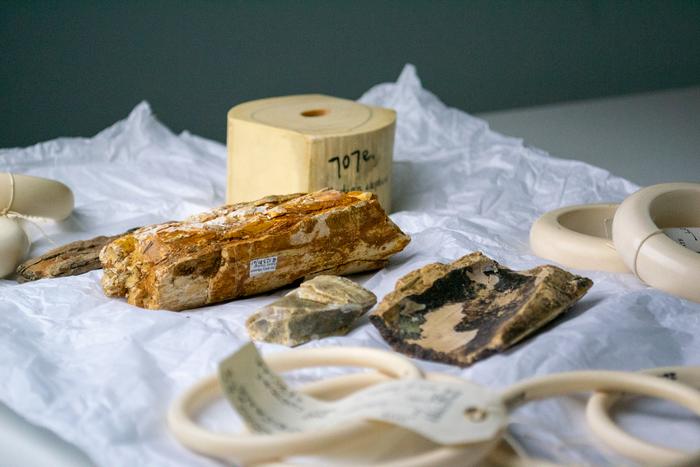A new way of quickly distinguishing between illegal elephant ivory and legal mammoth tusk ivory could prove critical to fighting the illegal ivory trade. A laser-based approach developed by scientists at the Universities of Bristol and Lancaster, could be used by customs worldwide to aid in the enforcement of illegal ivory from being traded under the guise of legal ivory. Results from the study are published in PLOS ONE today [24 April].

Credit: Ben Booth
A new way of quickly distinguishing between illegal elephant ivory and legal mammoth tusk ivory could prove critical to fighting the illegal ivory trade. A laser-based approach developed by scientists at the Universities of Bristol and Lancaster, could be used by customs worldwide to aid in the enforcement of illegal ivory from being traded under the guise of legal ivory. Results from the study are published in PLOS ONE today [24 April].
Despite the Convention on the International Trade in Endangered Species (CITES) ban on ivory, poaching associated with its illegal trade has not prevented the suffering of elephants and is estimated to cause an eight per cent loss in the world’s elephant population every year. The 2016 African Elephant Database survey estimated a total of 410,000 elephants remaining in Africa, a decrease of approximately 90,000 elephants from the previous 2013 report.
While trading/procuring elephant ivory is illegal, it is not illegal to sell ivory from extinct species, such as preserved mammoth tusk ivory. This legal source of ivory is now part of an increasing and lucrative ‘mammoth hunter’ industry. It also poses a time-consuming and enforcement problem for customs teams, as ivory from these two different types of tusk are broadly similar making it difficult to distinguish from one another, especially once specimens have become worked or carved.
In this new study, scientists from Bristol’s School of Anatomy and Lancaster Medical School sought to establish whether Raman spectroscopy, which is already used in the study of bone and mineral chemistry, could be modified to accurately detect differences in the chemistry of mammoth and elephant ivory. The non-destructive technology, which involves shining a high-energy light at an ivory specimen, can detect small biochemical differences in the tusks from elephants and mammoths.
Researchers scanned samples of mammoth and elephant tusks from London’s Natural History Museum using the laser based method, Raman spectroscopy. Results from the experiment found the technology provided accurate, quick and non-destructive species identification.
Dr Rebecca Shepherd, formerly of Lancaster Medical School and now at the University of Bristol’s School of Anatomy, explained “The gold standard method of identification recommended by The United Nations Office on Drugs and Crime for assessing the legality of ivory predominantly are expensive, destructive and time-consuming techniques.
“Raman spectroscopy can provide results quickly (a single scan takes only a few minutes), and is easier to use than current methods, making it easier to determine between illegal elephant ivory and legal mammoth tusk ivory. Increased surveillance and monitoring of samples passing through customs worldwide using Raman spectroscopy could act as a deterrent to those poaching endangered and critically endangered species of elephant.”
Dr Jemma Kerns of Lancaster Medical School, added: “The combined approach of a non-destructive laser-based method of Raman spectroscopy with advanced data analysis holds a lot of promise for the identification of unknown samples of ivory, which is especially important, given the increase in available mammoth tusks and the need for timely identification.”
Alice Roberts, Professor of Public Engagement in Science, from the University of Birmingham and one of the study’s co-authors, said: “There’s a real problem when it comes to stamping down on the illegal trade in elephant ivory. Because trading in ancient mammoth ivory is legal. The compete tusks of elephants and mammoths look very different, but if the ivory is cut into small pieces, it can be practically impossible to tell apart elephant ivory from well-preserved mammoth ivory. I was really pleased to be part of this project exploring a new technique for telling apart elephant and mammoth ivory. This is great science, and should help the enforcers – giving them a valuable and relatively inexpensive tool to help them spot illegal ivory.”
Professor Adrian Lister, one of the study’s co-authors from the Natural History Museum, added: “Stopping the trade in elephant ivory has been compromised by illegal ivory objects being described or disguised as mammoth ivory (for which trade is legal). A quick and reliable method for distinguishing the two has long been a goal, as other methods (such as radiocarbon dating and DNA analysis) are time-consuming and expensive. The demonstration that the two can be separated by Raman spectroscopy is therefore a significant step forward; also, this method (unlike the others) does not require any sampling, leaving the ivory object intact.”
Professor Charlotte Deane, Executive Chair of EPSRC, said: “By offering a quick and simple alternative to current methods, the use of Raman spectroscopy could play an important role in tackling the illegal ivory trade.
“The researchers’ work illustrates how the development and adoption of innovative new techniques can help us to address problems of global significance.”
The study was funded by the Engineering and Physical Sciences Research Council (EPSRC) and involved researchers from the Universities of Lancaster and Birmingham and the Natural History Museum.
Journal
PLoS ONE
Method of Research
Imaging analysis
Subject of Research
Animals
Article Title
Discrimination of ivory from extant and extinct elephant species using Raman spectroscopy: a potential non-destructive technique for combating illegal wildlife trade
Article Publication Date
24-Apr-2024
Discover more from Science
Subscribe to get the latest posts sent to your email.


